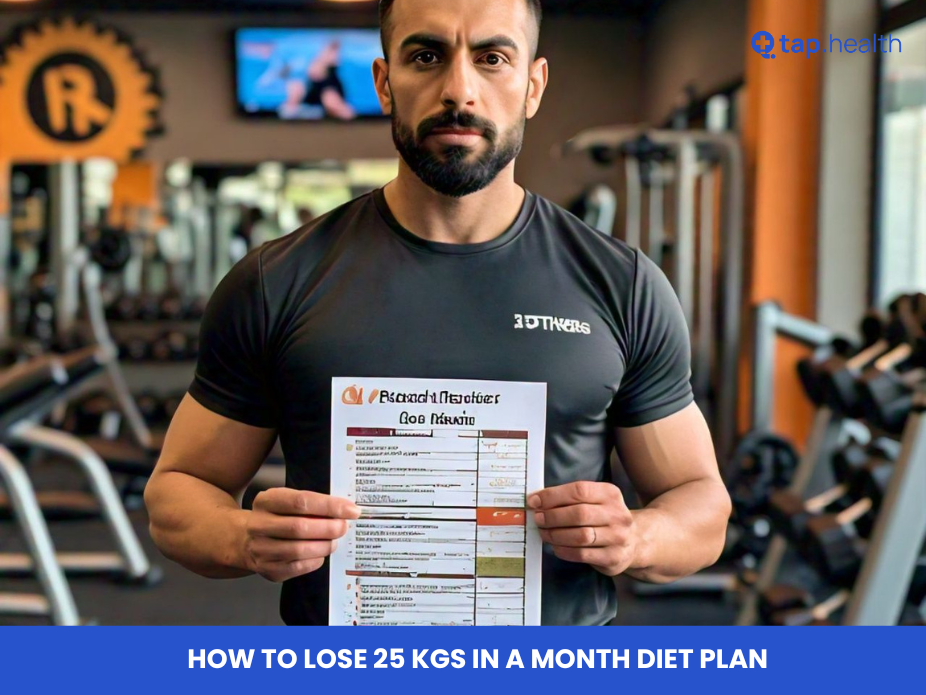Losing weight quickly is a goal many people dream of achieving. While some may hope to lose 25 kgs in a month, it is crucial to approach such an ambitious target with caution. Rapid weight loss, if not done properly, can be dangerous and unsustainable. However, if approached with the right strategies, discipline, and commitment, you can make significant progress toward losing weight quickly.
In this blog post, we will provide a safe and effective diet plan that may help you lose weight, including how to create a calorie deficit, the role of exercise, real-life scenarios, and expert advice. We’ll break down the steps for you and give you practical, research-backed recommendations for achieving your weight loss goals.
Understanding the Basics: How Does Weight Loss Work?
To lose weight, you need to create a calorie deficit, which means burning more calories than you consume. This is the foundation of any effective diet plan.
Key Principles of Weight Loss:
- Calories In vs. Calories Out: The basic principle of weight loss is that you need to burn more calories than you consume. One kilogram of body weight is approximately equal to 7,700 calories, so to lose 25 kg, you would need a total calorie deficit of around 192,500 calories. This means you’ll need to create a significant calorie deficit every day to lose 25 kgs in 30 days.
- Healthy vs. Extreme Weight Loss: Rapid weight loss may sound appealing, but it can have serious health consequences. Losing weight too quickly can lead to muscle loss, nutritional deficiencies, dehydration, and other issues. It’s important to lose weight at a safe pace and focus on creating lasting habits for long-term success.
- Exercise and Physical Activity: Exercise is crucial for weight loss as it helps you burn additional calories. A combination of cardio and strength training exercises will maximize fat loss while preserving muscle mass.
The 25 Kgs in a Month Plan: Safe and Practical Steps
While losing 25 kg in a month is an extreme goal, breaking down your approach into manageable steps is essential for safety and sustainability. The following approach emphasizes nutrient-dense foods, exercise, hydration, and other strategies that support fat loss.
1. Create a Significant Calorie Deficit
To achieve rapid weight loss, you need to significantly reduce your calorie intake and increase your calorie expenditure. A daily calorie deficit of 1,500–2,000 calories is an aggressive approach, but it’s important not to go too low on calories. Consuming fewer than 1,200 calories per day for women and 1,500 calories for men can lead to malnutrition, loss of muscle mass, and metabolic slowdown.
Sample Daily Calorie Breakdown:
- Breakfast: 300 calories
- Lunch: 400 calories
- Dinner: 400 calories
- Snacks: 200 calories
- Total: 1,300 calories
While cutting calories is essential, it’s just as important to focus on nutrient-dense foods that support your body’s needs.
2. Eat Nutrient-Dense Foods
When cutting calories, you must ensure you’re still getting the necessary nutrients to maintain health and energy. Focus on whole, unprocessed foods that are high in fiber, protein, and healthy fats.
- Lean Proteins: Skinless chicken, turkey, fish, tofu, and legumes are excellent sources of protein. Protein helps build and repair muscles, boosts metabolism, and keeps you feeling full for longer.
- Low-Glycemic Vegetables: Leafy greens, broccoli, spinach, kale, and zucchini are packed with vitamins, minerals, and fiber. These vegetables are also low in calories but high in essential nutrients.
- Whole Grains: Quinoa, oats, and brown rice provide fiber and healthy carbohydrates that keep your energy stable throughout the day.
- Healthy Fats: Avocados, nuts, and seeds offer healthy fats that support your metabolism and hormone balance.
Real-life Scenario:
Sarah, a 30-year-old woman aiming to lose weight for an upcoming vacation, reduced her calorie intake to 1,400 calories per day. She focused on eating lean proteins, lots of vegetables, and whole grains. Over three weeks, she lost 5 kg and felt more energetic than ever.
3. Incorporate Intermittent Fasting
Intermittent fasting (IF) is an eating pattern that cycles between periods of fasting and eating. IF may help you create a calorie deficit, and some studies suggest it can support fat loss and improve insulin sensitivity.
Popular intermittent fasting schedules include:
- 16/8 Method: Fast for 16 hours, then eat within an 8-hour window.
- 5:2 Diet: Eat normally for five days of the week and restrict calories on two non-consecutive days (500-600 calories).
Intermittent fasting helps restrict calorie intake while giving your digestive system time to rest and recover.
Expert Contribution:
Dr. Jason Fung, an expert in intermittent fasting, argues that fasting allows the body to enter fat-burning mode, reducing insulin levels and encouraging fat cells to release stored fat. His book The Obesity Code discusses how intermittent fasting and a low-carb diet can significantly help in weight loss.
4. Exercise Regularly
Exercise is essential to burn extra calories and promote fat loss. A combination of cardio exercises and strength training will help you maximize calorie burn and preserve lean muscle mass.
- Cardio: Activities like running, cycling, swimming, or brisk walking can burn calories quickly and improve cardiovascular health.
- Strength Training: Lifting weights or doing bodyweight exercises (squats, push-ups, lunges) will increase your metabolism, helping you burn more calories at rest.
Aim for 30–60 minutes of exercise daily, combining both cardio and strength training.
Real-life Scenario:
Tom, a 28-year-old man, committed to 45 minutes of cardio (running) and 30 minutes of strength training five days a week. Over the course of a month, he lost 10 kg while improving his overall fitness and muscle tone.
5. Stay Hydrated
Water is essential for fat loss. Drinking plenty of water throughout the day helps prevent overeating by reducing hunger, flushes out toxins, and supports metabolism. Aim to drink 2–3 liters of water per day, and avoid sugary beverages that add empty calories to your diet.
- Herbal teas like green tea and peppermint can also boost metabolism and help with digestion.
Why It Works:
Drinking water before meals can make you feel fuller, leading to a reduction in overall calorie intake. Additionally, staying hydrated helps your body function optimally, especially during intense exercise.
Read this: Is 800 Blood Sugar Normal?
Expert Contributions: Proven Weight Loss Strategies
Dr. Michael Mosley – Intermittent Fasting Expert
Dr. Mosley is known for his research on intermittent fasting. His work has shown that fasting can help with weight loss while improving insulin sensitivity and promoting metabolic health. According to his studies, fasting gives the body a chance to burn fat more efficiently.
Dr. Jason Fung – Nephrologist and Obesity Specialist
Dr. Fung advocates for intermittent fasting combined with low-carb eating to help patients lose weight safely and effectively. His approach focuses on reducing insulin levels, which play a major role in fat storage.
Recommendations Grounded in Proven Research
Scientific research supports a slow and steady approach to weight loss rather than drastic measures. According to a study in the Journal of Obesity, the best way to maintain long-term weight loss is through lifestyle changes, including balanced nutrition and regular physical activity. While extreme diets may show short-term results, they are often unsustainable and may lead to rebound weight gain.
FAQ: How to Lose 25 Kgs in a Month
1. Is it safe to lose 25 kgs in a month?
Losing 25 kgs in a month is an extreme goal and is not typically safe. Rapid weight loss can lead to dehydration, muscle loss, and nutritional deficiencies. It’s better to aim for sustainable, healthy weight loss over a longer period.
2. How much exercise should I do to lose 25 kgs?
Aim for at least 30 minutes of moderate cardio (like walking, jogging, or swimming) five days a week, combined with strength training two to three times a week.
3. Can intermittent fasting help me lose 25 kgs?
Intermittent fasting can help create a calorie deficit and may promote fat loss. However, it’s best combined with a balanced diet and exercise program for sustainable weight loss.
4. What are the best foods to eat on a weight loss plan?
Focus on lean proteins, low-calorie vegetables, whole grains, and healthy fats. Avoid processed foods, sugary snacks, and drinks.
References
- Harvard T.H. Chan School of Public Health. “The Science of Weight Loss.” Harvard Nutrition.
- National Institutes of Health (NIH). “Intermittent Fasting.” NIH.
Losing 25 kg in a month is an extreme target and should not be undertaken lightly. By following a safe and evidence-based diet plan, incorporating regular exercise, and staying committed to healthy habits, you can make significant strides toward achieving your weight loss goals. Always consult a healthcare professional before beginning any drastic diet or exercise plan.



